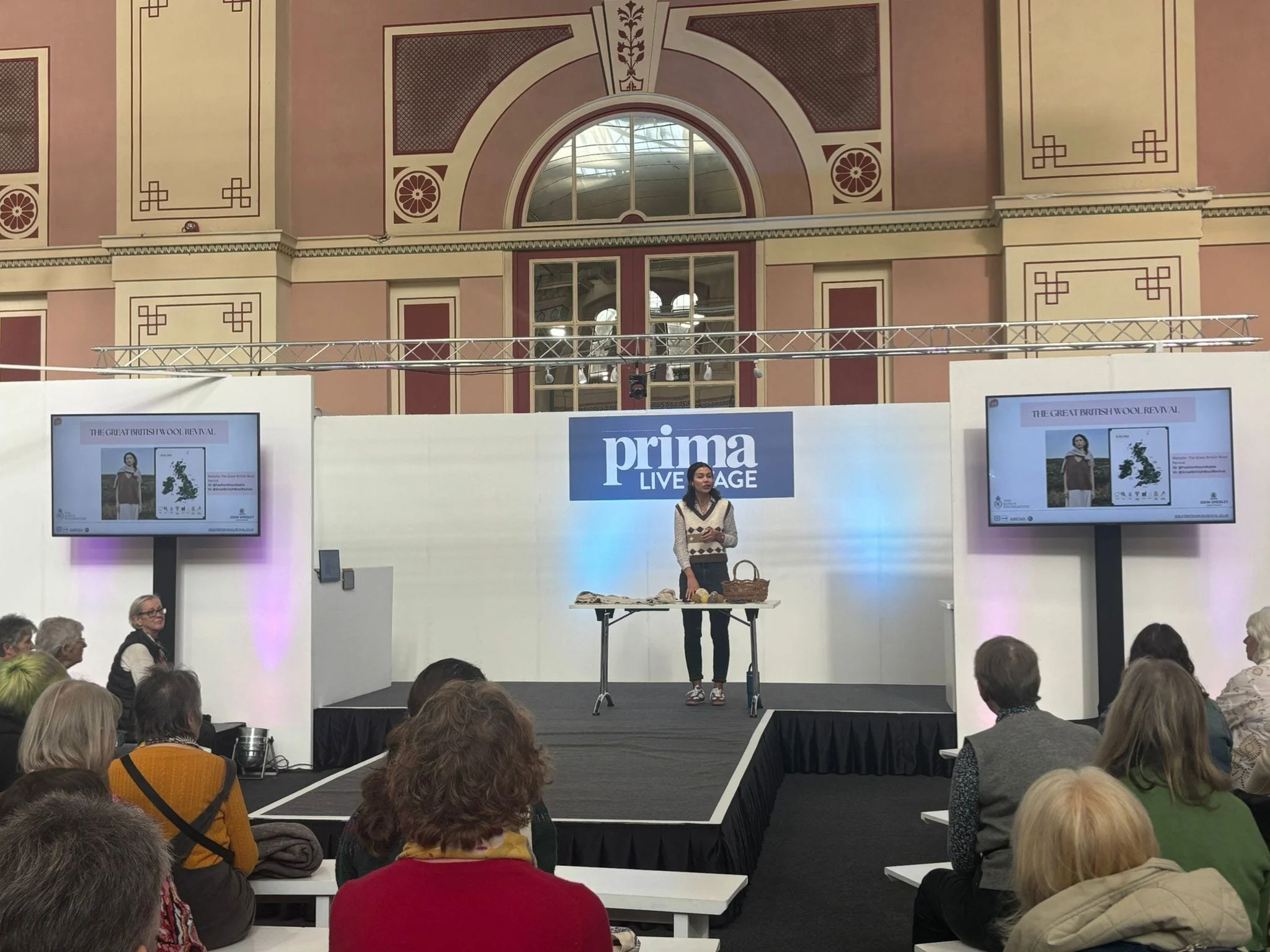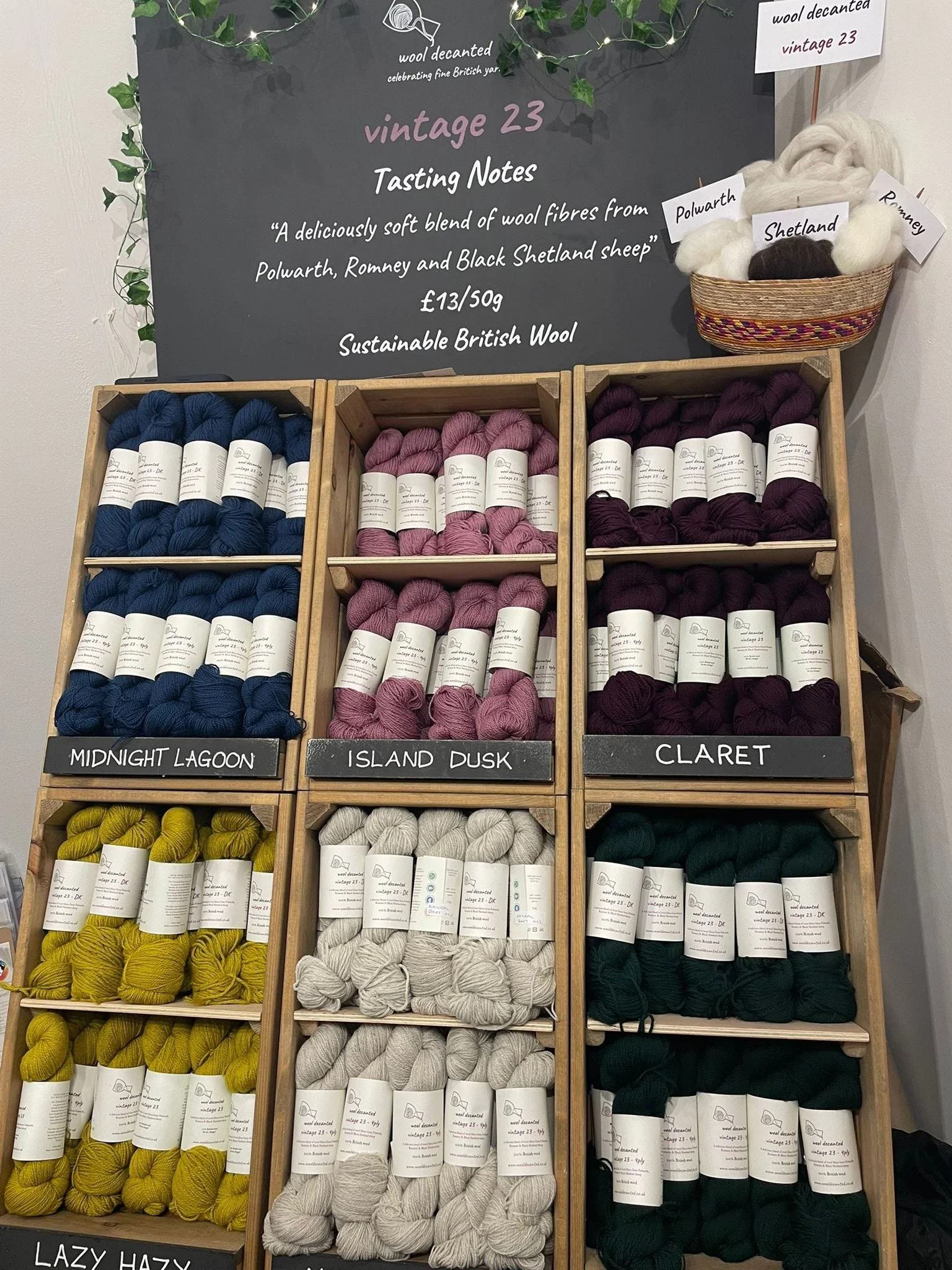Harriet, our Textiles Researcher and lead on the project The Great British Wool Revival spoke at Alexandra Palace - as part of Black, Indigenous and People of Colour working in the Fibre Industry
As part of the (BIPOC in Fiber) network, where she delved into the GBWR and its role in supporting students, designers and makers in the world of British wool
Ally Pally Stairs. Image Credit: Alexandra Palace
Harriet speaking on the Prima Live Stage: Image Credit: Tamara Cincik
Hear about the Ally Pally experience in her own words:
By Harriet Fletcher-Gilhuys
When I arrived at the train station at Alexandra Palace, I was overwhelmed with the beauty of Alexandra Park with the backdrop of the London skyline, the Shard and Gherkin glistening in the clouds. I was led up the hilly North London path where I was greeted by the outstanding Victorian palace and structure built in the 1870’s, which is commonly referred to as Ally Pally.
I made my way over to the Creative Living Theatre located in Alexandra Palace’s Grand Hall, surrounded by innovative creatives and makers showcasing a wide variety of products, from yarn hanks, garments, embroidery sets and creative paintings.
I finally arrived at the Prima (the magazine) stage, where I was scheduled to go on at 2.15pm, with my talk ‘British Wool: Farmer to Designer with Harriet Fletcher-Gilhuys’. The stage was completely packed, filled with inquisitive knitters and crafters, interested in learning about fibre provenance, heritage crafts, fibre sovereignty and local production in the modern day.
I opened my talk by introducing my background - growing up in rural Shropshire surrounded by farms and flocks, where I saw so much wool go to waste and farmers consistently at a financial loss, to how I linked this in with my research and studies at Nottingham Trent University and the Royal College of Art. Both of these projects used 100% raw British wool directly from farms in the UK, natural dyes and following best practice.
I spoke about my frustrations during my student years, that vital skills such as heritage crafts and regional fibre knowledge are not taught on fashion and textiles courses in the UK. This led to my natural rejection of the conventional teaching system, where I became completely self-taught in the world of British wool along with exceptional learnings from South East England Fibreshed and my own childhood experience.
I then led into my work and role as Textiles Researcher at Fashion Roundtable, and wool lead on The Great British Wool Revival. I spoke about the project’s leading role in supporting students, young designers, brands and businesses in joining-the-dots across the supply chain. It acts as a teaching facilitator to ensure that everyone wanting to work with British feels confident, well-informed and equipped with the terminology and tools required.
“We have over 200 brands and businesses on our map and this is continuously growing, with traction in over 44 different countries. This suggests that multiple communities are interested in working with their regional wool and are using the GBWR as a reference and proof of the concept. It has gained international recognition” - my opening words
I then went on to speak about ‘The Wool Story’ three part animation series that sits on the GBWR website, and traces the history of British wool from 4000 BC to the present day where British wool was once seen as a national asset to its sharp decline as a result of synthetics, mass production and the impacts of Covid.
This led wonderfully into our mapping overview, flagship projects including The King’s Foundation’s Modern Artisan Capsule Collection which included a unique yarn from the “Dumfries House Clip” that was then woven into an oversized limited-edition scarf with the support from Maria Benjamin and Zoe Fletcher from The Wool Library, all made on-shore in the British Isles.
Each piece in the collection considers our interaction with the natural environment from start to finish, prioritising deadstock, natural materials, British wool and natural dyes supported by Kate Turnbull from The Secret Dyery.
Finally, I wrapped up with an overview of the events we’ve attended this year - from Future Fabrics Expo, Groundswell Agriculture, London Design Festival and many more, where we’ve tried to bridge the gap between farmers and fashion speaking and engaging across both sides of the industry.
I then opened up to a Q&A for the audience to engage and ask pressing questions. Overall the presentation was very well received, with the audience nodding heads in admiration and mutual struggles.
“What do you do about rough scratchy wool only suitable for carpets?” asked a lady in the audience.
This is a common question that we get at the GBWR and seems to be a general theme around regional wool. I responded and explained that every British wool has its own natural characteristics and suitability for end use, this can often be utilised in outwear for tweeds and blankets.
Embroiders at Ally Pally. Image Credit: Harriet Fletcher-Gilhuys
Wool Decanted Yarns. Image Credit: Harriet Fletcher-Gilhuys
Overall, the experience at Ally Pally was really engaging, and it was great to connect with the wider knit, stitch, and craft community. The crowd was mixed, some were more focused on colour and cost than on natural fibres and their qualities. It would be wonderful to see greater engagement with fibre provenance and storytelling at events like the Knit & Stitch Show, to help drive meaningful systems change from makers all the way through to the final product.
This is part of the role that we play at The Great British Wool Revival, educating designers makers across the entire supply chain, championing British wool and its values creating heritage products for years to come. This includes our consultancy service where we tailor support by the hour, day or project from the field all the way through to the final product, travelling on your British wool journey with you!




